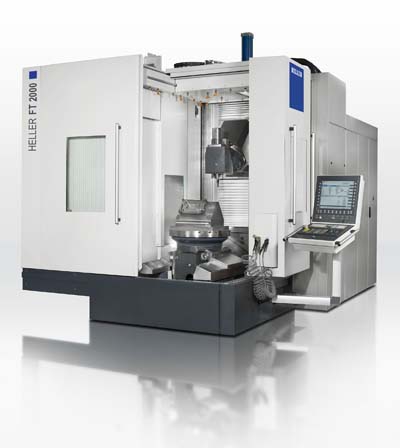
The versatile Heller F series HMCs for 5-axis simultaneous machining comes with three high performance spindle options for different cutting conditions and part configurations. Each HELLER machine delivers high torque at low speeds during milling, including simultaneous machining in five axes, ideal for complex contouring.
The new HELLER 5-axis machining center F2000 with swivel head includes many proven machine components from HELLER's modular machining center line and offers a large working area of 800X800X1000, (X, Y, Z). It can accommodate a 630mm pallet and 3080-lb workiece.
With three different high-performance spindles, the line offers options to machine smaller, lighter parts, frequently of tough material such as titanium, and aluminum parts that require high-speed machining.
The swivel-head provides a fifth axis that delivers a constantly high cutting performance in horizontal and vertical position as well as any spatial angle. This is of special importance for aerospace applications. The proven 5-axis kinematics provided by the tool in X, Y, C or A and two axes provided by the workpiece in the Z and B axis provide the user high precision, machining versatility and high dynamics.
According to the company, "After intensive market research, Heller engineers determined that the most flexible, robust, and efficient way to do 5-face and 5-axis machining is to have one of the axes in the work head. Using a B-axis table in combination with a universal or tilting work head allows greater table loads, larger working envelops and greater accessibility than 5-axis machines that have two axes of motion under the workpiece, such as a tilt/rotary table or C-over-B type."
The machine structure and axis design have been specifically tailored to the special requirements of 5-axis machining and it includes a HSK63 spindle taper and 242 Nm torque has been specifically designed for high performance. At the core of the F series machines is the innovative spindle technology. The PCU 63 is for high-performance cutting with speeds up to 10,000 RPM, power up to 44kW and torque up 244 Nm. Two other spindles go up to 16,000 RPM with 40kW of power and 80Nm of torque: the SCU 63 and the SCT 63 Tilt spindle. The SCT-63 is an A-axis head, in contrast to the others that are C-Axis.
The A-axis provides even more flexibility in cutting complex shapes. The two swivel-head units offer numerous advantages for complete machining of cubic parts in a single set-up, and the tilting head is ideal for machining of contoured surfaces of any kind, thus making it the perfect entry into 5-axis simultaneous machining, especially for aerospace applications. The use of the swivel spindle with HSK63 spindle taper provides cost savings and smoother running of the machine during the machining process. As a result, a top-quality surface finish and a significantly higher tool life and higher process stability can be achieved.
"Obviously, our customer industries have wide and varying applications, so the Heller consultative process is quite effective for the user. Because we are not a 'one-size-fits-all' builder, we work with our customers to be sure we configure F Series machines based on the type of work to be done, the production requirements, the material to be machined, and the type of CAD/CAM system used by the customer," said Trampus.
The powerful and structurally stiff machine setup can achieve a high cutting performance resulting in high chip removal rates while providing precision in theµm range. To assure machining precision, the F Series machines use a coded direct measuring system, high resolution rotary encoders and YRT bearings with integrated measuring system.
Contact Details
Related Glossary Terms
- gang cutting ( milling)
gang cutting ( milling)
Machining with several cutters mounted on a single arbor, generally for simultaneous cutting.
- machining center
machining center
CNC machine tool capable of drilling, reaming, tapping, milling and boring. Normally comes with an automatic toolchanger. See automatic toolchanger.
- milling
milling
Machining operation in which metal or other material is removed by applying power to a rotating cutter. In vertical milling, the cutting tool is mounted vertically on the spindle. In horizontal milling, the cutting tool is mounted horizontally, either directly on the spindle or on an arbor. Horizontal milling is further broken down into conventional milling, where the cutter rotates opposite the direction of feed, or “up” into the workpiece; and climb milling, where the cutter rotates in the direction of feed, or “down” into the workpiece. Milling operations include plane or surface milling, endmilling, facemilling, angle milling, form milling and profiling.
- precision machining ( precision measurement)
precision machining ( precision measurement)
Machining and measuring to exacting standards. Four basic considerations are: dimensions, or geometrical characteristics such as lengths, angles and diameters of which the sizes are numerically specified; limits, or the maximum and minimum sizes permissible for a specified dimension; tolerances, or the total permissible variations in size; and allowances, or the prescribed differences in dimensions between mating parts.






